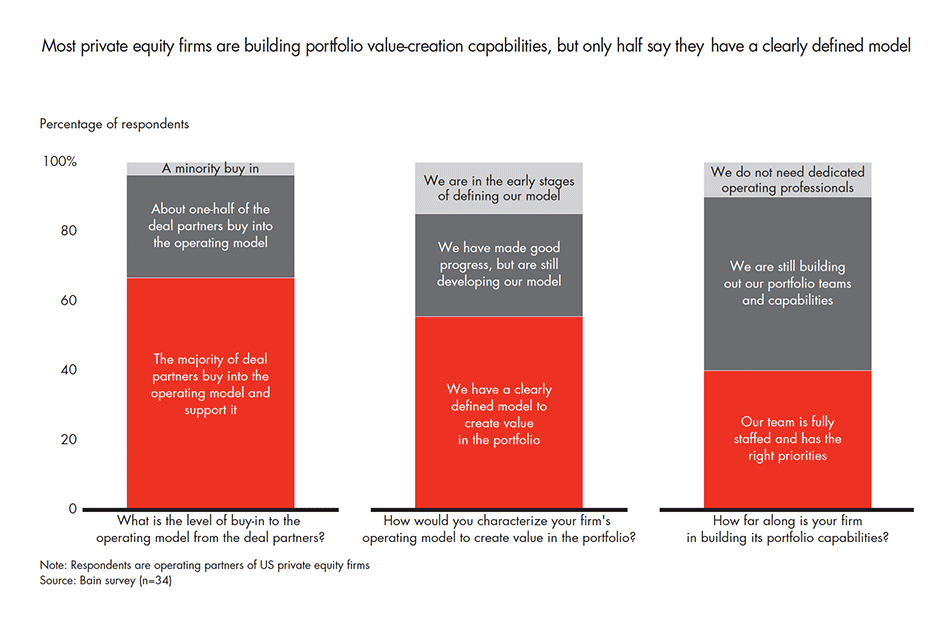Forbes.com
This article originally appeared on Forbes.com.
The turbulent investment climate of recent years has impressed upon nearly every PE firm worth its carry how important strong value-creation skills have become for grooming portfolios that can earn top-quartile returns. The challenge is not new, nor are the efforts to address it. Yet, as we report in Bain & Company’s Global Private Equity Report 2016, attempts to implant portfolio value-creation capabilities have too often been halting, scattershot and, in some cases, ineffective—and, even as 2016 began, too often nonexistent. A recent Bain survey of operating partners hired to head up portfolio value-creation initiatives found that only half of the respondents said that their firm had developed a clearly defined model for how to proceed (see figure).

There is no one winning formula for getting this right. Many leading PE firms are beginning to recognize that a solid portfolio value-creation program needs to flow organically from a firm’s unique strategy and values. Bain believes that any properly structured approach should be consistent in the way it acts across companies and address three interlinked issues: the firm’s philosophy, or its guiding objectives for value creation; its engagement model, or when, on what issues, how and with what resources it will intervene in its portfolio companies; and its organization, or what talent it needs (both internal and external) to execute the model and their roles and responsibilities for achieving success. Let’s look at four archetypal portfolio value-creation program approaches that capture these priorities.
The general activist model. Many large, well-capitalized PE firms build portfolio activism into their DNA. Their multidisciplinary operating teams bring a high level of engagement to each deal they do across the broad range of industries and sectors in which the firm invests. A firm-wide resource, the portfolio teams take over responsibility for the new companies that the firm acquires in the year after deals close, providing deep strategic analysis, supporting the development of value-creation blueprints and putting them into operation.
Adherents to the general activist model place a consistent emphasis on immediate post-acquisition collaboration with management, chiefly the first and second year of ownership. Together, they set out to create detailed, actionable blueprints for every investment that the firm makes and follow up by prioritizing between three and five key initiatives. The principal focus is on achieving significant topline growth. In-house teams typically initiate the blueprint process, put resources behind it and work day to day, and use an appropriate dashboard of key metrics to monitor the results, but portfolio company management owns the initiatives and is accountable for the outcomes.
The maestro model. A variant of the general activist approach, this model places the same emphasis on early, high-level and continuous engagement with management of the firm’s holdings across the entire portfolio, but it is well-suited for PE firms that lack the resources or desire to staff expensive in-house operating teams. Instead, the firm designates a senior managing director, working with a small internal staff and the firm’s individual deal teams, to coordinate and bring harmony to an ensemble of external experts. The outside advisers consist of seasoned executives, board members and consultants best suited to ensure the program has the operational support it needs and augment the management team’s capabilities to maximize the chances of success.
The adviser-led model. With an orientation to provide less interventionist support to portfolio company executive teams on a deal-by-deal basis, PE firms that adopt an adviser-led approach actively lean in on selected investments to help shape the management team’s goals and supply resources to enable it to achieve them. Adviser-led value creators typically eschew hiring dedicated portfolio operations teams and instead assemble a large network of outside experts who can parachute in to address focused needs or take on discrete technical roles.
The functional-playbook model. Some activists take a more hands-on prescriptive approach for creating value in their portfolio companies. PE firms that take a specialized functional approach to value creation need seasoned, full-time experts who can lead a cost-reduction program, achieve far-reaching operational improvements or implement other focused initiatives that make up their value-creation playbook.
As different as they are, these models share some common best practices. For one thing, the leaders staff their portfolio teams with the right experience and motivate their talent with the right incentives to achieve value-creation results. They ensure that there is clear buy-in across their organization about who has ownership of and accountability for value creation. They draw clear boundaries between the roles and responsibilities of deal teams, portfolio teams and external adviser networks. And they set firm decision rules for assigning their functional experts to initiatives that present the maximum value-creation opportunities.
Hugh MacArthur, Graham Elton, Dan Haas and Suvir Varma are leaders of Bain & Company’s Private Equity Group.
Carl Evander is a principal in Bain’s Private Equity Group.
